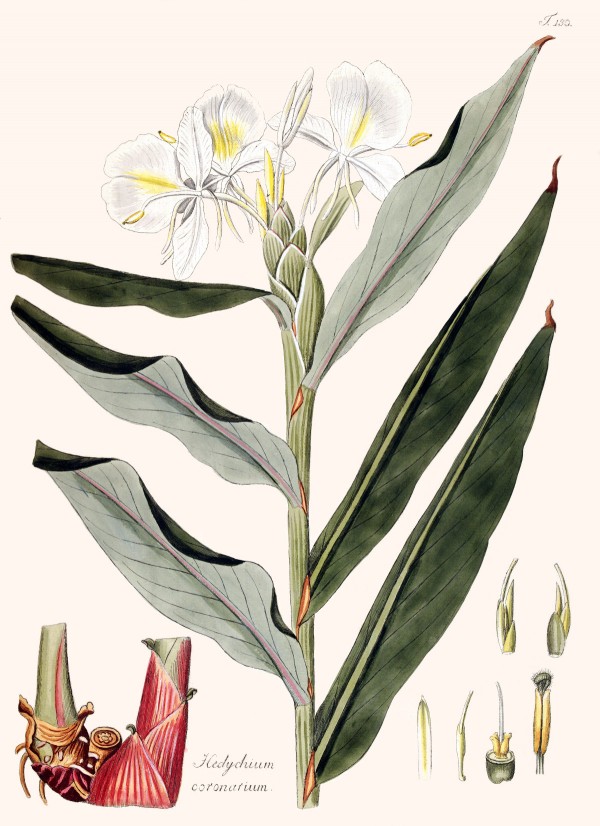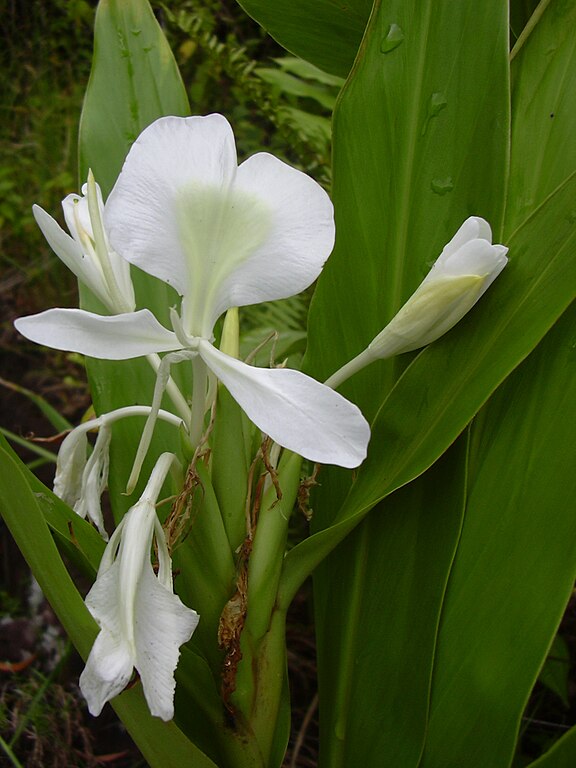Hedychium coronarium J.Koenig - Zingiberaceae - butterfly ginger, butterfly lily, garland flower, white ginger (lily), flor de mariposa (span.), Weißer Ingwer, Schmetterlingslilie, Schmetterlingsjasmin, Mariposa
Perennial herb, native to Asia (China, Taiwan, Laos, Myanmar, Nepal and India), naturalized and cultivated elsewhere; pseudostems well-developed, 1-3m tall, leaves oblanceolate or narrowly elliptic; flowers very fragrant, staminodes white, perianth pure white or white tinged with yellow.
https://npgsweb.ars-grin.gov/gringlobal/taxonomydetail.aspx?id=18576
http://www.efloras.org/florataxon.aspx?flora_id=1&taxon_id=200028392
„Hedychium means 'sweet snow', perhaps referring to the sweetly fragrant white blooms, or to the snow white insides of the edible, spicy tubers (not the ginger of commerce, which is Zingiber officinale).“ https://plants.ces.ncsu.edu/plants/all/hedychium-coronarium/
„Fragrant white flowers in dense elliptical racemes (4-8” long) in late summer to early fall. Individual flowers purportedly resemble butterflies, hence the sometimes used common name of butterfly ginger for this species.“ http://www.missouribotanicalgarden.org/PlantFinder/PlantFinderDetails.aspx?kempercode=a521
„The white mariposa, its scientific name Hedychium Coronarium, from the family of the Zingiberaceas, native to Vietnam, became a symbol of Cuban flora because Cuban women used it to smuggle messages to the battlefield during the liberation wars of the 19th century. Its perfume is exquisite. “ http://www.cubadiplomatica.cu/uganda/EN/LearnaboutCuba/Nativesymbols/NationalFlower.aspx
Of the 175 compounds identified (GC-MS) in the solvent extract and the headspace of Hedychium coronarium flowers, linalool, methyl benzoate, cis-jasmone, eugenol, (E)-isoeugenol, jasmin lactone, methyl jasmonate, methyl epi-jasmonate, indole, nitriles and oximes were found to make a great contribution to the scent of these flowers.
[Volatile components of Hedychium coronarium Koenig flowers., Matsumoto, F., Idetsuki, H., Harada, K., Nohara, I., Toyoda, T., Journal of Essential Oil Research, 5(2), 1993, 123-133]
The headspace of Hedychium coronarium flowers contained (R)-(-)-linalool (30.9%; 98.5%ee) with its strong floral note also known from tea and lavender.
[Analysis of enantiomeric ratios of aroma components in several flowers using a Chiramix column., Tamogami, S., Awano, K.I., Amaike, M., Takagi, Y., Kitahara, T., Flavour and fragrance journal, 19(1), 1-5, 2004]
„Hedychium coronarium flowers possess a scent which can be described as fresh, green, lily, and floral with a faint woody note…“
The major components of the headspace (SPME, GC-MS) of ginger lily flowers were (E)-β-ocimene (28.7%), linalool (19.3%), 1,8-cineole (14.5%), methyl benzoate (5.9%), β-caryophyllene (5.9%), (E,E)-α-farnesene (4.7%), and dendrolasin (5.0%). Minor constituents were eg cis-jasmone (0.2%), eugenol (<0.1%), indole (0.9%), (E)-isoeugenol (0.2%), phenylacetonitrile (0.2%), esters like methyl salicylate (<0.1%), linalyl acetate (0.2%), (Z)-3-hexenyl 2-methylbutanoate (0.2%), isobutyl benzoate (0.1%), and benzyl isopentanoate (0.2%).
[Báez, Disnelys, Jorge A. Pino, and Diego Morales. „Floral scent composition in Hedychium coronarium J. Koenig analyzed by SPME.“ Journal of Essential Oil Research 23.3 (2011): 64-67]
The major constituents of hydro-distilled oil from the fresh rhizome were 1,8-cineole (41.4%), β-pinene (10.3%), α-terpineol (8.8%), cymene (4.0%), α-pinene (4.0%), and terpinen-4-ol (3.5%). The major constituents of dried rhizome oil were 1,8-cineole (37.4%), β-pinene (17.4%), α-pinene (6.7%), and α-terpineol (6.7%).
[Antimicrobial activity and chemical composition of essential oil from Hedychium coronarium., Joy, B., Rajan, A., Abraham, E., Phytotherapy Research, 21(5), 2007, 439-443]
„Decoction of stem adjoining the rhizome is used as a gargle for tonsillitis, or the raw stem is chewed for same purpose. The juice of the stem is applied externally for swellings. The rhizome of the plant is used in the treatment of diabetes, headache (Bhandary et al.1995), cancer, inflammation, apoptosis, invasion and
osteoclastogenesis (Kunnumakkar et al., 2008). It is also used as anti-rheumatic, excitant, febrifuge and tonic.“
[Butterfly lilly (Hedychium coronarium Koenig): an endangered medicinal plant., Verma, M., Bansal, Y.K., Plant Archives, 10(2), 2010, 841-843]
„The major constituents in rhizome, stems and leaves oils included α-pinene (9.6%, 10.0% and 23.0%), β-pinene (39.1%, 38.8% and 44.1%), 1,8-cineole (32.2%, 5.6% and 5.1%) and α-terpineol (4.9%, 12.2% and 0.2%), while (E)-β-ocimene, linalool and 1,8-cineole were identified in the flower aroma when exposed to solid-phase microextraction fibers. In addition, the chiral examination showed a high enantiomeric excess (ca. 99%) for (3R)-(−)-linalool in rhizome and flowers, (4S)-(−)-α-terpineol in leaves and (1S)-(−)-borneol in stems.“
[Enantiomer differentiation of key volatile constituents from leaves, stems, rhizome and flowers of cultivated Hedychium coronarium Koenig from India., Shanmugam, P.V., Yadav, A., Chanotiya, C.S., Journal of Essential Oil Research, 27(2), 2015, 101-106]

Jacquin, N.J. von, Fragmenta botanica, figuris coloratis illustrata, t.130 (1809)
http://plantgenera.org/species.php?id_species=497252

Hedychium coronarium (flowers). Location: Maui, Hanawi stream (2003)
CC BY-SA 3.0, Author: Forest and Kim Starr Wikimedia Commons